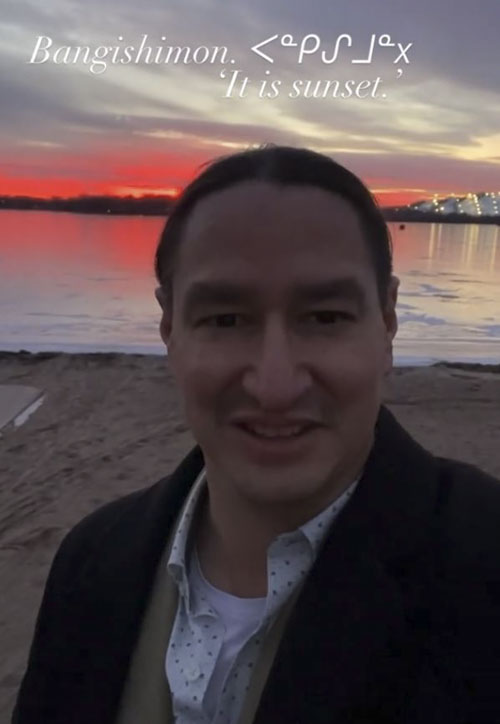A scene from Gatineau Park in Quebec, which lies on unceded Algonquin Anishinaabe territory.
Written by Lauren-Rose Stunell
Boozhoo – Hello!
You may know the Anishinaabemowin language as Ojibwe, Ojibwa, or even Chippewa. Dialects of this Algonquian language are spoken by Anishinaabe peoples mainly from Manitoba to Quebec, with a high concentration in the Great Lakes region and speaker populations as far west as Saskatchewan and Alberta. Anishinaabemowin is also spoken in Michigan, Wisconsin, Minnesota, North Dakota, and Montana in the United States. It is one of the most spoken Indigenous languages on Turtle Island (North America).
It is important to recognize that Anishinaabemowin belongs to the unique family of Algonquian languages that includes many other Indigenous languages, each with its own dialects, features, and characteristics. The culture and heritage of the Algonquin peoples are rich with oral traditions, stories, sacred ceremonies, land-based teachings, and creativity such as beadwork and quillwork.
A Modern Way to Learn Anishinaabemowin
With modern technology and social media, it has become easier for students and other Canadians to access Indigenous languages and to hear from those who speak and share their mother tongue. As educators, we are often fighting social media use in our classrooms; however, I challenge you to find a moment to celebrate modern technology and ask students to research some Indigenous knowledge keepers and Elders who are sharing their culture online. Listen and learn from them in your classroom to become better treaty people wherever you may live.
One of my personal favourites who I have had the honour of learning from is James Vukelich Kaagegaabaw, @jamesvukelich on TikTok. James is a speaker, author, and digital creator of Ojibwe descent living in Minnesota. I follow him to learn new words and sentences on my own journey towards reconciliation. I love that I have the opportunity to not only learn new words but also to learn their correct pronunciation.
Image: screenshot from this video on James’s TikTok account

Alongside the language, James also shares teachings from the Seven Grandfather Teachings and the Thirteen Grandmother Moons. Please familiarize yourself with these topics before starting the classroom activity. These beautiful teachings can create an inclusive classroom environment for all learners, especially your Indigenous students.
Heart Berries: A Sweet Connection Between Anishinaabemowin and Land-Based Teachings
Lesson Description
At the end of this lesson, students will be able to retell the story and teachings behind heart berries. They will familiarize themselves with Call to Action #13, which asks the government of Canada “to acknowledge that Aboriginal rights include Aboriginal language rights.” From the Seven Grandfather Teachings and the Thirteen Grandmother Moons, students will develop an understanding and appreciation for Indigenous stories, traditions, and medicines. They will be able to recognize the cultural significance of these aspects and understand how they have been passed down through generations. Students will appreciate the rich history and knowledge that Indigenous communities have preserved and continue to share through unique languages such as Anishinaabemowin.
Content
- Teachers can choose to give students time on their phones to look through James’s TikTok page. After their allotted time, each student can teach the class a new word that they learned from him. Gizhawenimin is my personal favourite, which will lead into the lesson. Teachers with younger students can show his page via screen or smartboard.
- Who are the Anishinaabe people? Teachers should show their class this three-minute video Who are the Anishinabek? from the Anishinabek Nation to introduce them to the people whose language they will learn about. Please note that this video is unique to Canada, but Anishinaabe land spans Turtle Island (North America) into the United States.
- Teachers can begin by asking how to say “I love you” in the target language. Have a classroom discussion in the target language about ways in which we show others love and why love is an important value. Teachers can discuss love in different relationships or environments and how it may be different from self-love or love for the land.
- Next, teachers can familiarize students with the Seven Grandfather Teachings and the Thirteen Grandmother Moons.
- To learn about heart berries, show this video from James to introduce students to this new word in Anishinaabemowin. The word ode’imin means “heart berry” or, as we know it, strawberry.
- Teachings shared with me explain that the strawberry is the only fruit with its seeds on the outside, showing and teaching vulnerability. “Heart berries” teach us about community and love. Students can share their understanding of love and teachers can stress the importance of sharing these teachings and learning new words in Anishinaabemowin in connection with the Calls to Action.
Call to Action #13 and Extension Activity
The Truth and Reconciliation Commission of Canada calls upon the government of Canada “to acknowledge that Aboriginal rights include Aboriginal language rights.” This Call to Action is the foundation of the lesson plan and can be used to create deeper understandings and extensions for older students. Teachers may choose to enhance students’ skills in this language by exploring the Anishinaabemdaa online language learning lessons. This resource is excellent not only for learning the language but also for understanding the history and culture behind the language and those who speak it.




